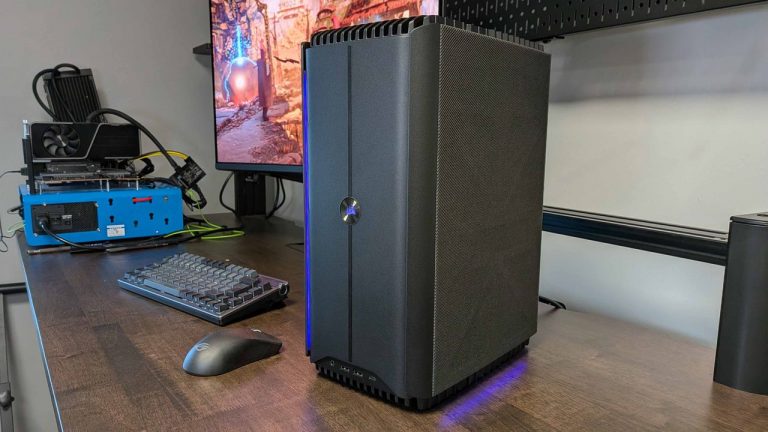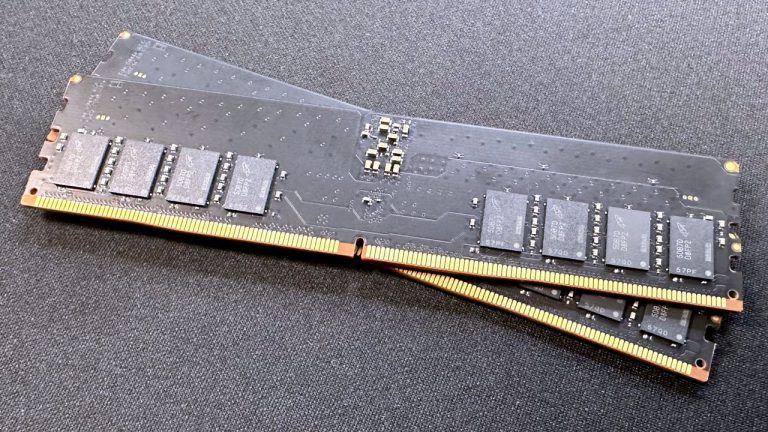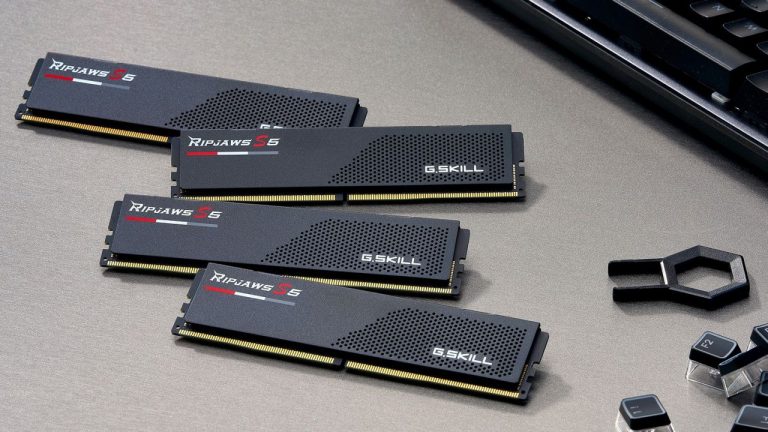Do you really need to wallop your retinas with 500 nits of full-screen SDR brightness on a daily basis? That question goes to the core of the new Asus ROG Swift OLED PG32UCDM. Because it’s painfully close to gaming monitor perfection save for one obvious limitation. Yup, full-screen brightness.
To be clear, this new Asus OLED panel doesn’t have a particular issue with full-screen brightness compared to other OLED monitors. It just doesn’t move the game on by that metric. On the other hand, it definitely does deliver where earlier OLED monitors haven’t in terms of pixel density and resolution. This is the real 4K deal, all 240Hz of it. And it’s pretty bloody glorious.
Cherish that thought while we motor through the various speeds and feeds. So, this is a 32-inch 4K monitor featuring Samsung’s latest QD-OLED panel tech. The 4K bit means much higher pixel density than before, which has in turn required a new ink-jet printing method for manufacturing the panel.
That new process doesn’t seem to have impacted the panel’s broader capabilities beyond the pixel density. It’s rated at the same 0.03ms response as previous QD-OLEDs, for instance, and the 250 nits full-screen brightness is likewise carried over, ditto the peak 1,000 nits for HDR brightness in very small windows, and 99% coverage of the DCI-P3 colour space.
Connectivity wise, you get DisplayPort 1.4, a pair of HDMI 2.1 ports, and USB-C with 90W of power delivery, not to mention a KVM switch. Basically all your connectivity bases are covered. It is worth noting that the full 240Hz at 4K is only possible via DSC or Display Stream Compression which theoretically adds to latency, but by such a small amount it really doesn’t matter (0.5 microseconds, if you’re wondering).
(Image credit: Future)
Screen size: 32-inch
Resolution: 3,840 x 2,160
Brightness: 250 nits full screen, 1,000 nits max HDR
Color coverage: 99% DCI-P3
Response time: 0.03ms
Refresh rate: 240Hz
HDR: DisplayHDR 400 True Black
Features: Samsung QD-OLED 3rd Gen panel, adaptive sync, 1x DisplayPort 1.4, 2x HDMI 2.1, 1x USB-C with 90W PD, KVM switch
Price: $1,299 | £1,349
As for other features, there’s HDR400 certification, a custom heatsink, a uniform brightness mode and various burn-in mitigation measures including pixel refresh and pixel shift. Incidentally, as is always the case with the latter, that involves an over provisioning of pixels which slightly increases the apparent size of the screen bezels.
Hardly a deal breaker, then, but if you are expecting that edge-to-edge OLED thing you get with TVs, you’ll be disappointed here. Nor are you getting a terribly grown up design.
Aesthetically, Asus’ ROG line of gaming peripherals seems to have slightly become stuck about 10 years ago. This is a nicely built screen. But the sharp lines, the RGB lighting, and the logos are all a bit adolescent and dated.
That’s no doubt fine for certain more affordable segments of the gaming market. But we’re talking about $1,299 worth of high-end monitor here. Some slightly less cheesy surrounds probably wouldn’t hurt.
(Image credit: Future)
With all that covered off, what’s this thing like to actually use? Mostly amazing is the answer. It’s a revelation to finally have an OLED desktop monitor, as opposed to a laptop or phone panel, with decent pixel density. It pretty much solves all those niggly font rendering issues that lower resolution OLED panels have had due to their weirdo subpixel layout.
It’s a revelation to finally have an OLED desktop monitor, as opposed to a laptop or phone panel, with decent pixel density.
That non-standard subpixel arrangement remains. But the density offsets it to the extent that the sharpness of text is very nearly identical to an RGB LCD with the same resolution and density.
That really matters, because it means this is the first OLED panel that you can use as an all-rounder without compromising on font quality. Yes, you can just see some fringing if you look really hard. But you do have to look awfully closely.
In other regards, this monitor looks much the same as previous QD-OLED panels. And that’s a good thing. The colours are amazing, the HDR performance is totally stunning. The response wallops pretty much any LCD monitor.
And then there’s the full-screen brightness. Which is where things get a tiny bit more complicated. At 250 nits it’s reasonable, the same in fact as pretty much all of the latest OLED panels, including Asus’s own 34 incher, the Asus ROG Swift OLED PG34WCDM. For most users indoors, that’s enough. But arguably only just. If you’re using this monitor in an environment with really bright ambient lighting, you’ll sometimes feel like you want a bit more pop.
(Image credit: Future)
But if there is a more pressing problem with brightness, it’s more to do with HDR gaming. Anytime the scene is mostly dark up to a roughly 50:50 mix of dark and light elements, this monitor absolutely sizzles. It renders neon lighting on a dark background in Cyberpunk 2077, for instance, as well or better than any monitor we’ve seen.
That’s partly helped by a very well judged glossy coating, which emphasises the OLED panel’s inherent contrast without adding too much reflectivity. It’s a genuine visual thrill.
No LCD panel can come close to the 0.03ms pixel response.
Where the Asus ROG Swift OLED PG32UCDM is less convincing—and again this is a problem it shares with every previous OLED monitor to date—is in really bright outdoor gaming scenes. In that scenario, the limited full-screen brightness is pretty obvious. Even a fairly basic 400 nit IPS monitor has this and every other OLED panel beat when it comes to rendering that kind of image.
(Image credit: Future)
(Image credit: Future)
(Image credit: Future)
(Image credit: Future)
(Image credit: Future)
(Image credit: Future)
But then do you really want to slap your retinas with upwards of 400 nits of full-screen sizzle every time you’re playing a game with a bright outdoor scene? Is that actually comfortable and sustainable?
That’s a tricky call. What is possible to say is that it would be preferable if this monitor at least gave you the option of doing that. The fact that it doesn’t is what ensures that this isn’t quite the perfect all-round gaming monitor.
(Image credit: Future)
For the record, this OLED panel also handles SDR content brilliantly in HDR mode. So, you can simply run it in HDR mode all the time with the SDR brightness turned up in the Windows Display Settings tool. There’s no need to jump back and forth between SDR and HDR mode in Windows all the time depending on the content you’re watching or playing.
As for response and latency, well, few will be disappointed. Yes, there are monitors with higher refresh rates. But no LCD panel can come close to the 0.03ms pixel response. Moreover, if you want to play at 500Hz, you’re not going to be in the market for a 4K panel of any kind.
(Image credit: Future)
This thing is easily slick enough and fast enough for 99% of gamers. The only real problem in that regard is that you’ll need a megbucks Nvidia RTX 4090 GPU to really make the most of that 4K at 240Hz combo.
Incidentally, if you were wondering if this new class of QD-OLED panel suffers from the same internal reflectivity issues as other QD-OLED panels, it does. So, yes, it can look a bit grey when there’s lots and lots of ambient light. But most of the time, it’s barely an issue and if you’re in a darkish room. For me, it’s a total non-issue.
✅ You want a high pixel density OLED experience: This is the first 4K OLED we’ve experienced and it definitely doesn’t disappoint.
❌ You demand really high full-screen brightness: Like every other OLED monitor, full-screen brightness remains a slight weakness.
Overall, then, this is a horribly desirably gaming monitor. Once you’ve tried it, it sort of spoils you for LCD panels. The perfect per-pixel lighting and amazing HDR performance, the incredible response, the essentially infinite viewing angles—by comparison, all LCD monitors are just a little bit clunky.
Indeed, it’s little things like having actually black bars above and below movies and a sense of absolutely even image quality across the entire panel that make this monitor feel so modern and LCD monitors feel just a bit dated by comparison.
The Asus ROG Swift OLED PG32UCDM is therefore not perfect but, as an overall proposition, it probably comes closer than any previous monitor. Only the hefty price and the knowledge that even better OLED panel tech is almost certain to appear in the coming years prevent this from being a total no brainer and an absolute must buy. But, if you’re in the market for an outstanding 4K gaming monitor right now, it’s the one.












